In June 1960, Patrice Émery Lumumba was elected the first prime minister of the Democratic Republic of the Congo. Just months later, he was murdered.
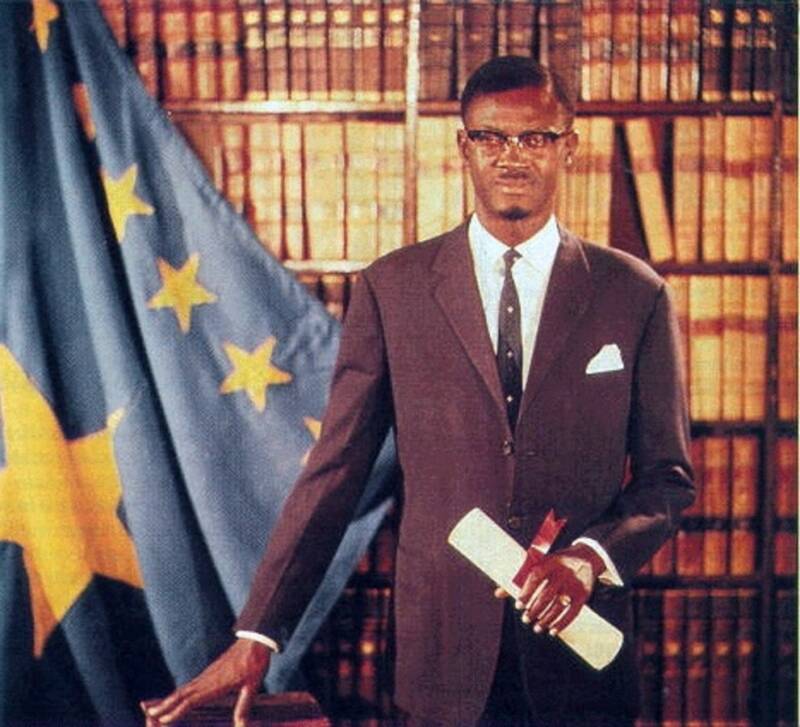
Wikimedia CommonsPatrice Lumumba served as the Congo’s prime minister for less than three months before he was dismissed.
For 75 years, Belgium ruled the Congo with nearly unprecedented brutality. From the reign of King Leopold II to its years as a Belgian colony, the country endured years of mass murder, rape, and mutilation. But in 1960, the Congo gained its independence — and it seemed like Patrice Lumumba was the perfect man to usher in a new chapter for his country.
A renowned Congolese independence leader, Lumumba was just 35 years old when he became prime minister. Bright, charismatic, and passionate about his cause, Lumumba promised the Congolese a fresh start. And during his first big speech as prime minister, he denounced the era of colonialism.
“No Congolese will be able to forget that [independence] was won in struggle, a struggle in blood, fire, and tears,” he declared, in front of an audience that included the Belgian king, Baudouin I.
Lumumba’s bold vision for the Congo’s future made him an iconic figure among his supporters. But his unapologetic condemnation of colonialism also made him many enemies — both at home and abroad. After less than three months in office, he was forcibly removed from power. And shortly thereafter, he was arrested, tortured, and assassinated.
Patrice Lumumba’s Path Toward Politics

Wikimedia CommonsA father in the Congo looks down at his child’s hand and foot, which were cut off when he didn’t meet his rubber production quota. Circa 1904.
By the time Patrice Émery Lumumba was born on July 2, 1925, Belgium had ruled the Congo for decades. Back in 1885, the Belgian King Leopold II had been awarded the swath of land in Africa by other European powers. He promised to bring “civilization” to what he called the “Congo Free State.”
Instead, the Belgian rule of the Congo was marked by brutality. About 10 million Congolese people were killed during King Leopold’s reign alone — which lasted from 1885 to 1908. Countless others were mutilated for failing to meet production quotas for rubber, ivory, and minerals.
And even when the Congo became a Belgian colony — under control of the Belgian government rather than just one man — that didn’t mean the brutality came to an end. Many Congolese people were still forced into labor and abused by the Belgians who remained in the country.
Plus, the Congolese were considered second-class citizens in their own country. Before 1958, native Congolese couldn’t vote, hold office or high-ranking positions in the army, or attend Belgian universities.
This was the world that Patrice Lumumba grew up in — and his connection to the Congo’s violent past ran deep. Born into the Batetela tribe, he’d seen his people forcibly dispersed throughout the country. In addition, many Batetela people were victims of Belgium’s routine mutilations.
For much of his life, Lumumba had some distance from the more brutal aspects of Belgian rule. He attended religious schools run by white missionaries. Ambitious and intelligent, he got a respectable job at the post office when he was just 19 and tried to change the system from the inside.
But Lumumba’s father had never let him forget the violence suffered by his ancestors at the hands of Belgian colonists. Because of him, Lumumba felt inspired to speak out about “Africa for Africans.” In 1953, he was arrested for embezzling money from the post office, but his supporters claimed that he only took the money to support his nationalist causes.
By that point, Patrice Lumumba had his eye on one goal: independence.
The Birth Of Congolese Independence
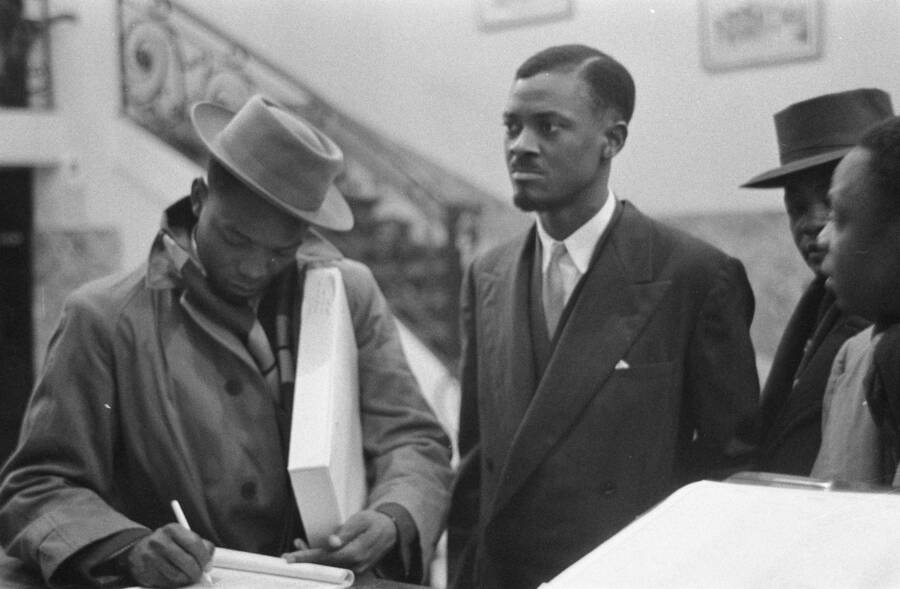
Wikimedia CommonsPatrice Lumumba flew to Belgium to discuss Congolese independence before it even happened.
By the 1950s, Patrice Lumumba was squarely involved in Congolese politics. In 1958, he helped create the Mouvement National Congolais (MNC), a pro-independence party in the Congo.
The MNC was unique among Congolese political parties. It was not organized along ethnic or tribal lines. Instead, it was meant to unite the Congolese people as a whole. Along with Congolese independence, the party also advocated for neutrality in foreign affairs. Meanwhile, as the Belgians watched Lumumba’s rise, they began to suspect him of being a Communist.
But the Belgians could also see the writing on the wall. Although they threw Lumumba in jail after an anti-colonial riot in 1959, they couldn’t suppress his appeal to many Congolese people who were tired of Belgian brutality. When the Belgians convened a round-table in Brussels to discuss Congolese independence, Lumumba personally flew to Belgium as a delegate.
And once he helped the Congo win its independence, he was determined to make sure that his voice was heard.
After two round-table conferences in early 1960, Congolese and Belgian delegates returned to the Congo to recognize its independence on June 30, 1960. By this point, Lumumba had been chosen to be the country’s prime minister, serving with the president, Joseph Kasa-Vubu.

Congopresse/Wikimedia CommonsPatrice Lumumba ratifying the Congo’s independence with Belgian Prime Minister Gaston Eyskens.
At the Palais de la Nation in the Congo, King Baudouin of Belgium gave a speech describing Congolese independence as a Belgian “gift.” He also praised King Leopold II — whose reign over the Congolese people had been particularly brutal. Next, Kasa-Vubu applauded Belgium and reassured the journalists present that, fundamentally, nothing would change.
But then, it was Patrice Lumumba’s turn. The new prime minister rose before the crowd. And he gave a thundering indictment of the Belgian brutality that had scarred the Congo for years.
“Morning, noon, and night we were subjected to jeers, insults, and blows because we were ‘Negroes,'” Lumumba roared. “We have seen our lands seized in the name of ostensibly just laws, which gave recognition only to the right of might. We have not forgotten that the law was never the same for the white and the black.”
“We can rely not only on our own enormous forces and immense wealth,” Lumumba added, “but also on the assistance of the numerous foreign states, whose co-operation we shall accept when it is not aimed at imposing upon us an alien policy, but is given in a spirit of friendship.”
Lumumba’s speech raised hackles among the Western delegates. In 1960, the world was in the midst of the Cold War — and those in the West didn’t like what Lumumba was saying about “numerous foreign states.”
“Premier Lumumba’s speech produced comments of surprise and disappointment among Belgian and other Western representatives,” noted The New York Times the next day. “The Soviet diplomats present seemed to be enjoying the occasion.”
However, the honeymoon of Congolese independence — and Patrice Lumumba’s tenure as prime minister — would be short-lived.
The Plot To Kill Patrice Lumumba
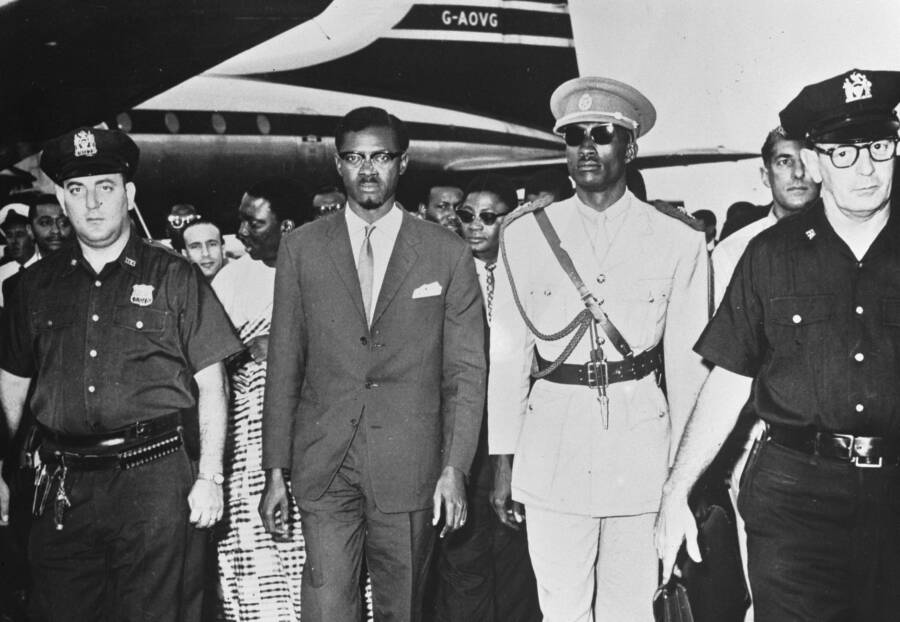
Wikimedia CommonsPatrice Lumumba arrives in New York City on July 24, 1960, following a series of crises in the Congo.
Only a few days after the Congo’s independence was established, the country tumbled into crisis. On July 5, 1960, the nation’s army — which contained no Congolese officers — threw out all of its Belgian members. Then, the army began to harass Belgians who were still living in the Congo.
Belgium responded by sending in paratroopers. They claimed that they were only doing this to protect civilians. However, many took their action as a sign that they would try to take over the country again.
Lumumba appealed to the United States for help — and was refused. Next, he turned to the United Nations, who sent in peacekeeping troops to assist him — but did little else. Lumumba was frustrated by the conditions in his country and finally turned to the Soviet Union out of desperation.
“If I need to sell my soul to the devil in order to save the country, I will not hesitate to do so,” he said. “I am confident that, with the full support of the Soviets, we will come out victorious.”
But in the meantime, Lumumba soon realized that he was losing a valuable ally — the Congo’s president, Kasa-Vubu.
In September, the Western-backed Kasa-Vubu dismissed the Soviet-backed Lumumba. The country — which was already torn apart — fell deeper into chaos as Lumumba attempted to regain power. Meanwhile, American and British operatives mulled over how they could quickly solve the crisis.
In Washington, President Dwight Eisenhower reportedly expressed “his wish that Lumumba would fall into a river full of crocodiles.”
And Larry Devlin, the CIA station chief in Kinshasa, wrote, “The President would have vastly preferred to have him taken care of some other way than by assassination, but he regarded Lumumba as I did and as a lot of other people did as a mad dog… and he wanted the problem dealt with.”
In a meeting with Eisenhower, British Foreign Secretary Sir Alec Douglas-Home “stressed that now is the time to get rid of Lumumba.” British Prime Minister Harold MacMillan called Lumumba a “Communist stooge” and apparently wanted him gone. And Belgium’s Minister of African Affairs ordered Lumumba’s “elimination definitive” – his physical elimination.
Inside The Death Of Patrice Lumumba
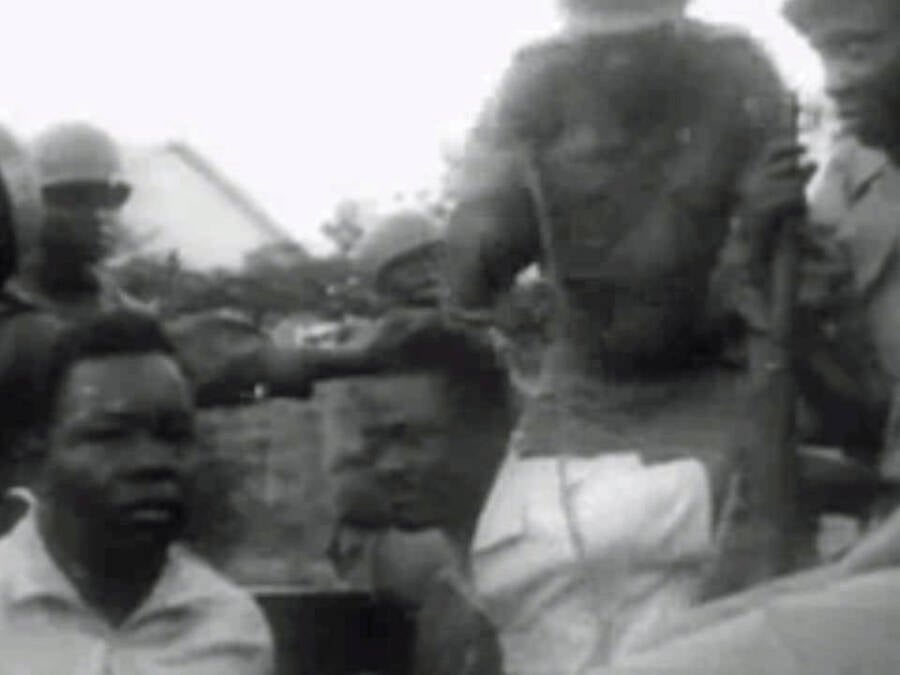
Wikimedia CommonsA blurry picture captures the arrest of Patrice Lumumba.
By mid-September 1960, the power struggle between Kasa-Vubu and Lumumba led to military intervention. This was led by Joseph-Désiré Mobutu, the army chief of staff who was determined to keep Lumumba out of power. He enjoyed support from Belgium and the United States.
Under Mobutu’s orders, Lumumba was placed under house arrest. But at some point in November, he was able to escape. Lumumba fled toward the city of Kinshasa, heading for his supporters in the east. Although he made it across the Sankuru River — and nearly to safety — he turned back when he saw that others, including his wife Pauline, had been captured by soldiers.
Approaching the soldiers, he addressed them in what would be his last speech: “If you kill me, I will not die. If you throw me into the river, the fish will eat my flesh. The Congolese will eat the fish, and then I will be in the bellies of the people and I will never be far from my people.”
It was early December when Lumumba was captured by Mobutu’s forces — and he would be dead in just a little over a month. In the weeks leading up to Patrice Lumumba’s death, he was held at a military camp, but some wondered whether the camp was secure enough to keep him from escaping.
On January 17, 1961, Lumumba and two political associates were moved via airplane to another area in the country — where they had many enemies. For hours, the three men were brutally tortured by Belgian and Congolese officers. Then, they were taken to the woods outside of Lubumbashi, the Katangese capital. There, they were all fatally shot by a firing squad.
Some sources say that it was a Congolese firing squad, while others maintain that it was a group of Belgians. Although it remains unclear who shot the fatal bullets, both Belgian and Congolese officers were involved in the torture leading up to Patrice Lumumba’s death. And men from both countries were apparently present for his final moments.
In an effort to make the bodies “disappear,” a Belgian police officer named Gerard Soete later chopped up the corpses and dissolved them in acid.
The dream of an independent and truly democratic Congo died with Lumumba. He was just 35 years old.
The Legacy Of The Congo’s First Prime Minister
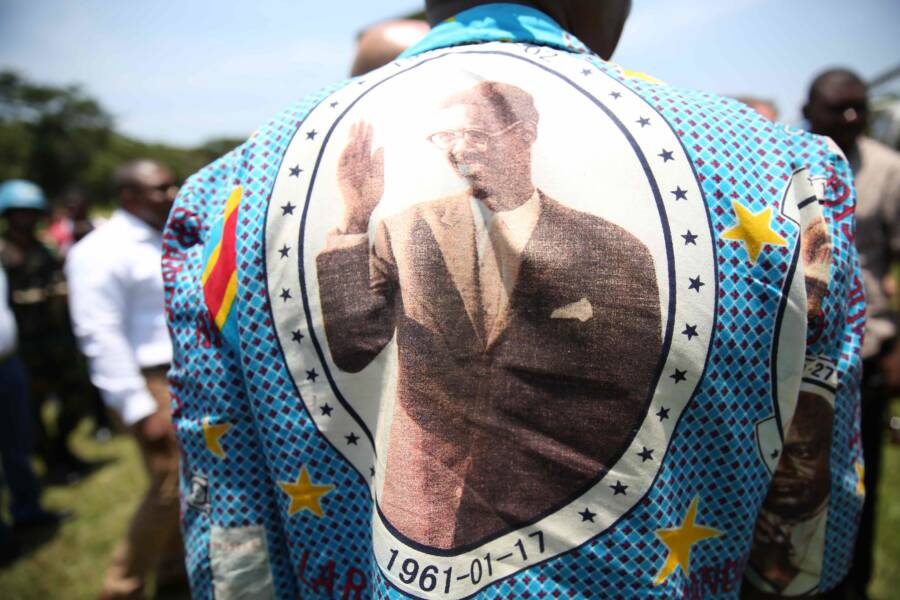
MONUSCO Photos/FlickrA man in the Congo wears a jacket depicting Patrice Lumumba.
Patrice Lumumba’s death left his supporters shocked, saddened, and outraged. It also left them with a burning question: What could the Congo have been, under his guidance?
After his death, the sabotaged country spiraled into a five-year-long civil war that cost tens of thousands of lives. Moïse Tshombe won the 1965 elections, but the Western-backed Mobutu declared a state of emergency, accused Tshombe of treason, and seized power. Mobutu claimed that, after a short period of military rule, democracy would be restored.
Instead, he renamed himself Mobutu Sese Seko, renamed the country Zaire, and clung to power until 1997. His reign was marked by severe corruption, mismanagement, and support for equally brutal dictators and factions in Africa. One of his strongest supporters was the United States, which supplied him with millions of dollars each year until the end.
To this day, many of the details surrounding Patrice Lumumba’s assassination are unclear. But there’s little doubt that Belgium, the United States, and Britain all played some type of role in his death.
In August 1960, the CIA established “Project Wizard” — a covert action program that helped lead to Lumumba’s downfall. As Lumumba struggled to regain control of the country, they funneled money to his political enemies, including Kasa-Vubu and Mobutu.
Devlin, the Congo-based CIA agent, even claimed that the United States had given him direct orders to assassinate Lumumba — although he’d refused to follow them. And an MI6 officer told a friend on her deathbed that Britain had also played a hand in Lumumba’s murder — by helping to organize it.
In 2002, Belgium apologized for its role in Patrice Lumumba’s death, saying: “The time has come to present to the family of Patrice Lumumba and the Congolese people its profound and sincere regrets and apologies for the sorrow that was inflicted upon them.”
But apologies will do little to heal the original wound. The world will never know what the Congo might have been if its first prime minister had been given a chance to lead it. It’s little wonder why Patrice Lumumba’s death is often called “the most important assassination of the 20th century.”
After learning about Patrice Lumumba’s death, read about Steve Biko, the anti-apartheid activist who was killed by South African police. Then, check out 44 photos of African kingdoms before European colonists stormed in.





